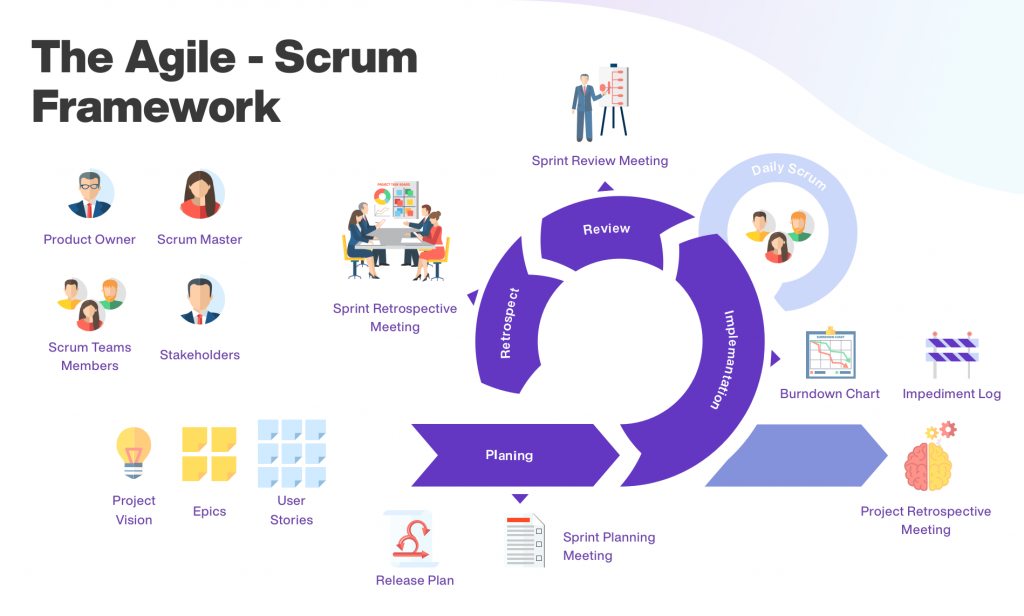
Whoever said that being a project manager is easy has never had that responsibility. To carry out a project successfully, you need dedication, patience, and organization.
Rely on the most effective tools and methodologies to be successful. Applying existing and proven processes for managing projects can save you a lot of effort and minimize risks. Here, I will describe some of the best methodologies and tools to make your project a success.
Mastering agile project management in 30 minutes or less
Success doesn’t come from not making mistakes, but from not making the same mistake twice. This is one of the chief values of Agile methodologies: adapt and improve. This principle, among others, offers an improvement over outdated management methods that used to fuel the world of software development. The Agile Manifesto summarizes these principles perfectly.
Agile Manifesto
The agile manifesto features:
❖ Individuals and interactions over processes and tools
❖ Working software over comprehensive documentation
❖ Customer collaboration over contract negotiation
❖ Responding to change over following a plan
We call Agile to all the methods, frameworks, or processes that follow these values. These methodologies have many advantages, such as helping teams manage work more efficiently while delivering high-quality products on a budget.
The two most recognized within the Agile methodologies are Scrum and Kanban. Before I discuss them, keep in mind that the main advantage of Agile is to be adaptable without losing efficiency.
Therefore, its guidelines aren’t rigid and without taking other factors into account, they are a stable roadmap for the team. Let’s see these agile examples in real life by exploring how these methodologies look like in every day activities.
How Scrum works

Quality work is everyone’s responsibility. Therefore, this methodology focuses on team harmony and usefulness. Scrum teams are self-organizing and cross-functional.
Self-organizing teams actively choose the best way to get their work done, rather than outsiders leading them. Cross-functional teams have all the skills needed to meet goals.
To improve is to change, to perfect is to change often. In Scrum, the model team optimizes flexibility, adaptability, creativity, and productivity. These features are valuable when developing a new idea or when the project scope changes during market research.
I will list below the four most significant Scrum concepts and explain how to apply them practically.
1. Scrum Team: Here are the team roles predefined for better collaboration:
- Product Owner (PO): The PO is responsible for understanding business and market requirements. This person represents the interests of the customer and communicates the vision of the product. They receive input from users and stakeholders, manage priorities, respond to team inquiries about requirements, and define acceptance criteria.
- Scrum Master (SM): The SM educates the team, the PO, and the company on Scrum processes. In charge to manage the team’s workflow and schedule, and provide all the necessary resources to complete each task. They ensure that all parties adopt Scrum in the best way.
- Development team: The team also includes professionals with different skills, such as developers, testers, a technical leader, etc. All team members must support each other to be successful. The most efficient Scrum teams usually have a maximum of five members.
2. Sprint: A sprint is an iteration of the project with a defined timeline, fixed during its execution (timeboxing). The goal of each sprint is to implement a list of product backlog items (PBIs). A PBI specifies a requirement. There are several types of items: bugs, tasks, epics, etc.
A story is a type of PBI. A story specifies a functionality, written as follows: As a <role>, I want to <feature> so that <reason>. For example, a story from a photo editing app might be: “As a user, I want to be able to take pictures directly from the app, so that I can filter them and share them on my social media easily.” The result at the end of the sprint should be a potentially deployable, integrated, and tested increase in functionality.
3. Scrum meetings: The Scrum team must have the following meetings:
a. Planning: The team reviews the PBIs and defines which ones will be targeted during the next sprint. In this meeting, team members also set the sprint’s objective. We estimate each GDP in story points.
b. Daily: In a quick 10-minute daily meeting, team members share what they’ve done, what’s next, and any issues they’re facing.
c. Review/Demo: The participants review the sprint outcome to update the PBI list if necessary. The development team, PO, and stakeholders all participate. They review completed items.
d. Retrospective: The goal of this meeting is to assess the performance of people, relationships, processes, and tools during the sprint. It serves to identify crucial elements that went well and opportunities to improve. As a next step, the participants create an action plan. The PO can participate.
e. Backlog refinement: In this ongoing backlog maintenance meeting, participants estimate items and split larger ones into smaller, manageable parts. The PO and the SM participate. Part of the development team can participate.
4. Product backlog: It’s an ordered list of ideas and requirements to develop. The person responsible for it is the Product Owner. Hierarchical priorities set it. You can add or remove items at any time.
How Kanban works
“If there is no explicit limit to work-in-progress and no signaling to pull new work through the system, it is not a kanban system.”
― David J. Anderson, Kanban
Teams choose Kanban for its ability to quickly deliver results, ensuring on-time production. When a business that relies on constant value creation stalls, they’re not optimizing their workflow effectively. By focusing on workflow, Kanban shifts the team’s mindset to prioritize finishing tasks over starting them.
What are the core elements of Kanban?
Kanban consists of a board with cards located in columns with a number at the top of each one.
● Cards: They represent the units of work as they progress through the development process.
● Work in progress (WIP) limit: The number at the top of a column shows the limit of cards allowed. This is the big difference between a Kanban board and an ordinary task board. The team enters a new item only if there’s a free space in the corresponding column of the board.
However, Kanban encompasses more than just a board. What we know today as Kanban supports six crucial workflow principles:
- Visualize workflow: This is the most fundamental step to adopt and implement the Kanban method. You need to visualize, either on a physical or electronic Kanban board, the steps of the process.
- Limit WIP: Limiting WIP means focusing on completing a certain number of tasks and then starting on the next ones. Less is more, so when WIP is low, the lead time is shorter, and throughput is higher. As I mentioned earlier, each board column has a WIP limit to prevent exceeding the maximum card count.
- Manage flow: Managing flow is about analyzing the process for creating items and developing outputs to identify unproductive areas and improve. The team can do so by using Kanban metrics:
- Lead time: Measures the time lapse from item creation to completion.
- Cycle time: Represents the time lapse between the start of a task and its completion.
- Cumulative flow: Shows the number of tasks at each stage of the development process and their progress over time. The items in different columns on the board are color-coded to create a flow chart.
4. Make explicit policies: Add detailed instructions to the Kanban board’s column descriptions. That way, everyone knows the task criteria and how items move between columns.
During the “Coding” step of development, a policy mandates that the code review must complete before approving the item for testing. Additionally, someone must conduct a unit test on an item to consider it “completed.” In the “Testing” step, document and discuss the testing plan with the team before implementing it.
5. Implement feedback loops: Feedback loops are the foundation of an efficient system. Early feedback is crucial for delivering the right result quickly. Therefore, the Kanban method recommends the following three types of feedback loops:
Getting things done:
- Kanban meeting: This brief 10-minute daily meeting keeps the team focused by discussing tasks and potential obstacles for the day.
Delivery planning meeting:
- This meeting is for setting deadlines and creating a delivery plan, it lasts from one to two hours.
Doing things better:
- Monthly meeting to evaluate performance and make improvements in the workflow. On average, this meeting lasts one hour.
- Monthly meeting to review risk management parameters and minimize obstacles to team’s ability to deliver. Although it normally lasts an hour, it can take up to two hours.
- A review meeting held twice a week to check if the work is meeting the client’s expectations. Ideally, this meeting should last 30 minutes or less.
Doing the right things:
- Longest meeting (4-5 hours), strategy review helps business understand industry changes and internal needs. This meeting happens every three months to discuss and assess things like goals, markets, business position, strategies, and production.
- The team has weekly meetings. During these meetings, they discuss how to complete tasks. They consider adding more team members or figuring out what is needed to progress tasks. They last for up to 30 minutes.
6. Improve collaboratively, evolve experimentally:
Quality is not accidental. It comes from intention, effort, direction, and skillful execution. Quality means choosing the best option from many choices.
The Kanban method is a process of evolutionary improvement. It helps to adopt small changes and gradually improve at a rate the team can easily handle.
Project management tools I recommend
In a survey by Processmaker, 78% of the leaders said they have implemented PM software to ensure their team remains productive.
Good communication is as stimulating and useful for work as black coffee. At BEON Tech Studio, we have been using Slack since 2014 to talk to our team every day. It has chat channels, groups, video calls, DMs, reminders, and more.
At BEON, we mainly use Jira and Trello for project management. These tools have a straightforward layout and support Agile methods like Scrum and Kanban for complex projects.
Finally, for time tracking, there are also many tools available, including Toggl, Timenotes, and TimeCamp. Another one is Hubstaff, which we use to analyze and report equipment performance and time usage to our clients.
Agile project management summary
Being a project manager isn’t easy. However, today’s tools can help them move work forward at a steady pace.
We saw widely used but customizable agile examples in real life. Agile methods and tools are great for software projects. They prioritize customer needs and deliver consistent results.
At BEON Tech Studio, we strive to use the best practices and tools to effectively organize our work in every project. We believe in utilizing the most efficient methods and resources to ensure successful project management.
Our goal is to consistently deliver high-quality results by implementing industry-leading techniques and technologies. We are committed to staying up-to-date with the latest advancements in project organization and continuously improving our processes.
Would you like to know more about how we work? Drop us a line, we will answer you today.
Michel decided to dedicate his life to the software industry at a very short age. He graduated with a degree in Computer Science and Mathematics. Since founding BEON, he and Damian have worked hard to establish it as an elite company, providing the best engineer LATAM talent to major U.S. companies.
Explore our
Founding an International Software Agency—The Story of BEON’s Founders
When we learn about successful startups, we rarely hear about the obstacles and pitfalls the founders faced as these businesses grew. ..
API Security: Top 10 Most Common Risks and Their Prevention
With so many people depending on them, risk management regarding APIs is becoming an increasingly relevant topic in the software industry. ..
How to manage a development team: 6 keys for success
To be a great project manager, you must be a good leader, coworker, and supervisor. ..






